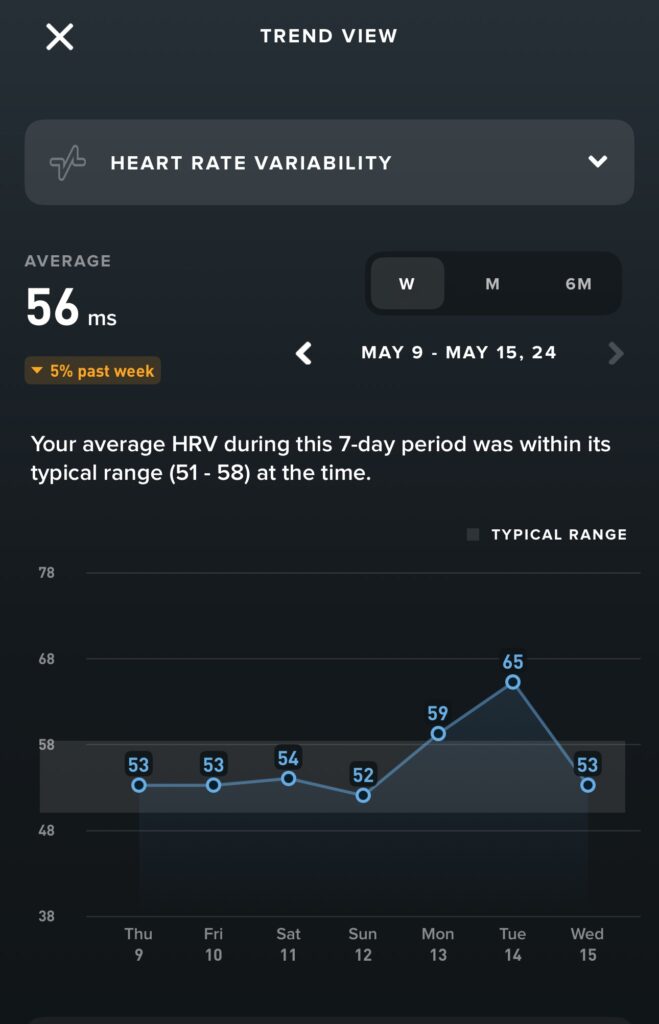I am consistently amazed by the amount of data and information that we can access overall and this is especially true with regards to the functioning of our bodies. It’s simply amazing to me. When I first got interested in endurance sports, which has been multiple decades now I will acknowledge, people were literally writing books and magazine articles and the most sophisticated physiological metric in use was the manual monitoring of one’s pulse. In 2024, the amount of data and analytics available to us is overwhelming. Part of my work at Digman Health and Performance is to monitor the options of such technology to determine if it’s usable data, and if so, what does it offer to us. I am not a fan of technology for the simple novelty of it. To my thinking, all the data we gather should be sound scientifically and then it should tell us something, ideally something we can influence.
Heart rate variability as a metric has been known and studied in medical research for several decades. Before going too far in what we might gain from the measure, we need to explain what it is first. Here I am going to be describing physiology in a broad brush strokes approach. The first point to note is that your heart rate is a responsive process, a variety of information from a diverse set of sources influences exactly when your heart beats. When at rest, two of the primary drivers of heart rate are the parasympathetic and sympathetic nervous systems. These are often known as the “rest and digest” versus “fight or flight” systems. As the labels probably make clear, these systems have opposite effects on heart rate when they are activated. The parasympthathetic effect is for a decrease in heart rate while the sympathetic brings about an increase in heart rate. At rest, both of these two effects are continually acting. When both are influencing heart rate, it is not entirely consistent with beats varying every so slightly. Heart rate variability is a measure of these tiny variations. It should be noted that these differences are occuring on a tiny, fraction of a second type basis such that human counting or a heart rate monitor will detect a consistent heart rate even with these tiny accelerations and decelerations taking place. Generally speaking, the greater the heart rate variability, the greater the parasympathetic activity.
Because parasympathetic activity is associated with the body resting, and the sympathetic with activitation due to physical or mental stress, increases in HRV are associated with recovery. This is why athletes find the metric so useful. Variations in heart rate variability are quite accurate in terms of measuring the body’s response to exercise. If an idividual has a decrease in their heart rate variability from their baseline, it shows that the body is still recovering from the stress it experienced. Assuming all else equal, that could well be the variation in exercise stress the person experienced. A return to baseline HRV values suggests the completition of the recovery process from exercise.

As we can see from this screenshot of a Whoop readout for my HRV, one can establish a typical baseline value and then note changes on the short term from that value. This week in May saw me riding my bike most days, including some harder rides. My HRV stayed pretty stable with a notable increase from the low 50s up to 65. That is the reading that followed my only day off the bike in this week, i.e. my body noticed the lack of physical exertion and HRV values refelcted it with the notable increase.
Heart rate variability is not just useful for athletes though. HRV also correlates with risk factors for cardiac events, cardiac related mortality and cardiorespiratory fitness overall. As such, HRV has been a part of cardiology research for a number of decades. The early studies, however, didn’t show information that could be easily used on a day to day basis. HRV was initially calculated by hand from the strips that printed out as part of a EKG.

In the last few years with the growth of wearable technology, HRV data has become widely available. I tend towards skepticism in terms of new technology and health related trends. It didn’t take me long to realize, however that HRV is a very usable metric for monitoring and improving health. This is not to say that I think we should base our lives around HRV, I do think it’s something many people should understand and check in with somwhat regularly. The process of integrating HRV monitoring into one’s life is not necessarily a simple one. Some positive health behaviors, such as vigorous exercise, will produce a short term reduction of HRV. One simply can’t stop doing things that decrease HRV, i.e. exercise, so using the tool is a process based on the totality of an individuals’ life over a manner of weeks and months, not days. It’s also important to note that HRV correlates with health outcomes but is a measurement that does not in of itself have health implications. In short, we are not going to be able to explain all aspects of using HRV in your life in this artlcle. Please reach out to us at Digman Health and Performance if you’re interested in learning more about applying this useful metric to your life. In the end, HRV is a useful tool for monitoring exercise load and overall health and stress when it’s used properly.

